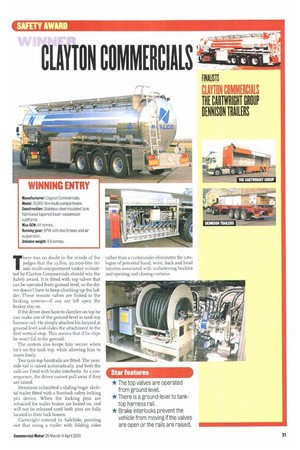CLAYTON COMMERCIALS
Page 33

If you've noticed an error in this article please click here to report it so we can fix it.
There was no doubt in the minds of the judges that the 13.6m, 30,000-litre triaxle multi-compartment tanker submitted by Clayton Commercials should win the Safety award. It is fitted with top valves that can be operated from ground level, so the driver doesn't have to keep climbing up the ladder. These remote valves are linked to the braking system—if any are left open the brakes stay on.
If the driver does have to clamber on top he can make use of the ground-level to tank-top harness rail. He simply attaches his lanyard at ground level and slides the attachment to the first vertical stop. This means that if he slips he won't fall to the ground.
The system also keeps him secure when he's on the tank top, while allowing him to move freely.
Two tank-top handrails are fitted. The nearside rail is raised automatically, and both the rails are fitted with brake interlocks. As a consequence, the driver cannot pull away if they are raised.
Dennison submitted a sliding-bogie skeletal trailer fitted with a Surelock safety locking pin device. When the locking pins are retracted the trailer brakes are locked on, and will not be released until both pins are fully located in their lock bosses_ Cartwright entered its SafeSide, pointing out that using a trailer with folding sides
rather than a curtainsider eliminates the catalogue of potential hand, wrist, back and head injuries associated with unfastening buckles and opening and closing curtains.








































































































